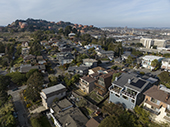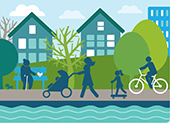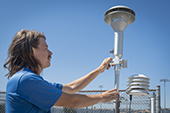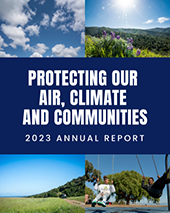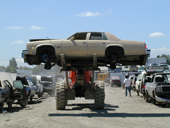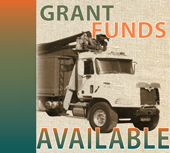|
|

|
|
|
|
August 2024 l Volume 2024-3
|
|
|
|
|
|
|
In this issue, you’ll find articles about the Air District’s adoption of a plan to improve air quality in the Richmond-North Richmond-San Pablo area, the launch of a new subscription service that will provide Bay Area residents with timely information about significant events affecting regional and local air quality, and a landmark settlement agreement with the Environmental Democracy Project to further a shared commitment to transparency, public health and environmental justice. Other articles cover the opening of a new air monitoring station in Benicia, the Air District Hearing Board’s issuance of an abatement order requiring Tesla to correct air quality violations at its facility in Fremont, publication of the Air District’s Annual Report, and an increase in the incentive amount available for Bay Area residents to improve local air quality by scrapping their 1998 and older vehicles. Current grant opportunities are also summarized.
|
|
|
|
|
|
|
|
|
|
|
|
|
|
Air District Board of Directors Adopts Path to Clean Air Plan to Improve Air Quality in Richmond-North Richmond-San Pablo
|
|
| | |
|
The Air District’s Board of Directors has adopted the Path to Clean Air Community Emissions Reduction Plan for Richmond-North Richmond-San Pablo. The plan was created in partnership with the Path to Clean Air Community Steering Committee, which includes local community members, public agencies, and other stakeholders. The plan identifies critical air quality and public health concerns and offers actionable solutions to address them.
The plan covers the cities of Richmond and San Pablo and several unincorporated areas in Contra Costa County, including North Richmond, that are impacted by air pollution sources that include fuel refining, ships, marine terminals, industrial manufacturing facilities, railways, vehicles, and freight traffic.
According to CalEnviroScreen 4.0, several communities in the Path to Clean Air area rank in the 90th percentile of pollution burden in California. A 2018 Contra Costa Health Services study shows that asthma rates in the county are higher on average than in the rest of the state and are especially high for children and Black residents.
The California Resources Board will consider the plan for approval later this year. To learn more, visit the Air District’s Path to Clean Air web page.
The Path to Clean Air Plan was developed as a requirement of AB 617, a state law which recognizes that while California has seen tremendous improvement in air quality, not all communities have benefited equally, and some communities located close to freeways, ports, industry, or other large pollution sources need additional focus and resources to reduce exposure levels.
|
|
|
|
|
|
|
|
|
|
|
|
Air District Rolls Out New Air Quality Incident Notification Service
|
|
| | |
|
The Air District has launched a new subscription service that will provide Bay Area residents with timely information about significant events affecting regional and local air quality. Residents can sign up on the Air Quality Incident Notifications web page to register for emails and text notifications about short- or long-term incidents that might affect their specific counties or the entire Bay Area.
This new subscription service will help the Air District get the word out quickly to Bay Area residents when incidents like industrial fires, refinery flaring, wildfires, or widespread odors are affecting local or regional air quality. It will augment the regional Spare the Air program by providing notice when air quality is being affected by specific events in the Bay Area and enable the public to receive more localized messaging about air quality conditions in their community.
These Air Quality Incident Notifications are a courtesy service the Air District is providing to help Bay Area residents track notable air quality incidents in their communities. However, they are not a replacement for other important sources of air quality information - such as local community warning systems, Spare the Air Alerts, the U.S. EPA Fire and Smoke Map, or local media coverage - and should not be relied on as a sole source of information about local air quality events.
|
|
|
|
|
|
|
|
|
|
|
|
Air District and Environmental Democracy Project Announce Landmark Settlement Agreement
|
|
| | |
|
This July, the Air District and the Environmental Democracy Project announced a landmark settlement agreement designed to further a shared commitment to transparency, public health and environmental justice. The Air District reached a positive resolution with the Environmental Democracy Project to address community concerns and enhance reporting and public engagement practices under the Air Toxics “Hot Spots” Information and Assessment Act of 1987. It will provide communities with vital information about the health risks posed by industrial emissions.
As part of this agreement, the Air District has committed to several key actions:
- Annual Health Risk Reports: The Air District will publish annual reports identifying industrial facilities that pose cancer risks and other health threats. These reports will include information about each facility’s toxic air pollutant emissions and will be distributed to county boards of supervisors, city councils and local health officials.
- Public Hearings: The Air District will hold public hearings to present these reports and discuss their significance, giving the community the opportunity to engage with the findings and understand their implications.
- Comprehensive Facility Map: The Air District will include information about each facility’s emissions on a comprehensive facility map available on its website. Making this information more easily available on the internet will serve as a critical tool for community members seeking to understand local environmental health risks.
The Air District will continue to work closely with community stakeholders, including the Environmental Democracy Project, to ensure that residents living near industrial facilities are well-informed about health risks from emissions.
|
|
|
|
|
|
|
|
|
|
|
|
Air District Launches New Air Monitoring Station in Benicia
|
|
| | |
|
In July, the Air District opened a new air monitoring station in Benicia, as part of the agency’s efforts to expand its air monitoring network in areas where large sources of pollution may contribute to localized pollution sources that are not captured by the Air District’s existing network. The additional data generated by community monitors, like the Benicia air monitoring station, will provide refinery frontline communities with real-time, local-scale air pollution data, reflecting day-to-day cumulative air pollution levels. This data also supports analysis of air quality trends and other air quality assessments.
The Air District is prioritizing communities with petroleum refineries and large renewable fuels manufacturing facilities. The new station, the Benicia-Fitzgerald air monitoring station, is located near East 2nd and East J Street in Benicia. It provides real-time data on the following pollutants: particulate matter, or PM2.5, ozone, nitrogen dioxide, nitric oxide, nitrogen oxides, sulfur dioxide, hydrogen sulfide, and black carbon.
While the Air District operates numerous ambient air monitoring stations across the Bay Area, the data from those stations does not reflect pollutant concentrations in every neighborhood. Exposure to pollution varies from place to place, and some communities near large industrial facilities bear a disproportionate burden from air emissions.
Data from the Benicia Monitoring station can be found on the Air District’s Air Monitoring Data website.
|
|
|
|
|
|
|
|
|
|
|
|
Air District Hearing Board Orders Tesla to Correct Ongoing Air Quality Violations
|
|
| | |
|
In June, the Air District’s independent Hearing Board issued an abatement order requiring Tesla to correct air quality violations at its electric vehicle manufacturing facility in Fremont. The Air District sought the abatement order to stop frequent and ongoing violations from the facility’s paint shop operations. Tesla has emitted harmful precursor organic compounds and toxic air contaminants directly into the atmosphere without proper abatement, resulting in over 112 Notices of Violation since 2019. According to some estimates, each of these violations may have resulted in the emission of hundreds of pounds of illegal air pollution. The violations have been frequent, recurring and can negatively affect public health and the environment.
The order requires Tesla to implement a plan to address these recurring violations through a two-step process:
- First, hire a third-party consultant to do an evaluation and make recommendations. Tesla must then develop a proposed implementation plan to implement the recommendations, which it will file with the Hearing Board for approval.
- Second, execute the implementation plan as approved by the Hearing Board to stop the avoidable release of uncontrolled emissions, except where it may be absolutely necessary for safety reasons.
Tesla’s recurring violations result from a variety of causes. In some cases, Tesla’s thermal oxidizer or related components of the abatement system break down repeatedly and Tesla’s system design causes emissions to automatically be vented directly into the atmosphere.
In other cases, the abatement equipment is functioning properly, but Tesla shuts the abatement system down when there are problems with other equipment in the paint shops. This has happened even when these problems are caused by Tesla staff or its contractors, and unabated emissions are sent into the atmosphere.
|
|
|
|
|
|
|
|
|
|
|
|
Protecting Our Air, Climate and Communities: 2023 Annual Report Highlights Notable Achievements in Air Quality Protections
|
|
| | |
|
The Air District’s 2023 annual report highlights our achievements over the past year through a dynamic website featuring original video content and animated graphics. In 2023, we continued our mission to reduce the disproportionate levels of air pollution that many communities face and provide clean air for all Bay Area residents. Through our community-focused programs, groundbreaking rule amendments and innovative climate protection programs, we strengthened our ability to reduce emissions and climate-warming pollutants.
Check out our accomplishments in the Air District’s 2023 Annual Report: Protecting Our Air, Climate and Communities.
|
|
|
|
|
|
|
|
|
|
|
|
Starting this Summer, the Air District is Offering $1,500 to Scrap Old Cars Through the Vehicle Buy Back Program
|
|
| | |
|
As of July 1, the Air District will offer $1,500 to Bay Area residents to improve local air quality by scrapping their 1998 and older vehicles through the Vehicle Buy Back Program. The program pays owners of older, high-polluting cars and small trucks to voluntarily retire their vehicles. Older vehicles lack modern emission-control technology and pollute at a higher rate than newer models.
Eligibility requirements for the Vehicle Buy Back Program include the following:
- Vehicle must be 1998 model year or older
- Vehicle must be currently registered as operable and must be drivable
- Vehicle must have been registered in the Bay Area for the past 24 months
- Vehicles within 60 days of a required smog check must take and pass smog check
The program reduces air pollutants from vehicle exhaust, including fine particles and ozone precursors, the main ingredients in smog. These pollutants contribute to respiratory diseases and increased mortality rates. Retiring older vehicles also reduces carbon dioxide, a potent greenhouse gas that contributes to climate change.
Since 1996, the Air District’s Vehicle Buy Back program has retired over 95,000 cars, vans, pickup trucks, and SUVs. For each pre-1998 vehicle removed from Bay Area roads, an estimated 75 pounds of air pollution is prevented from being emitted into the air annually.
The State of California operates a complimentary program offering eligible consumers vehicle retirement options for vehicles that do not pass smog check. View more information on the state's Consumer Assistance Program.
|
|
|
|
|
|
|
|
|
|
|
|
Air District Offers Millions in Grants
|
|
| | |
|
The Air District administers a number of grant funding programs that offer incentives for clean air projects. Grant Funding for Clean Air Projects
Grant programs for Bay Area businesses and public agencies:
- Competitive Electric Charging Infrastructure for Medium- and Heavy-duty Vehicles and Equipment - Funding is available for eligible projects that install new or expand existing battery-charging and hydrogen fueling stations. $35 million in funding is available with at least 80 percent being allocated for projects that operate in areas that are most highly impacted by air pollution, including the AB 617-identified communities of West Oakland, East Oakland, Richmond-San Pablo, and Bayview Hunters Point/Southeast San Francisco, and other disadvantaged and low-income areas in the Bay Area.
Applications are due on August 1, 2024, and will be awarded on a competitive basis. More information about eligible project categories and program requirements is located on the website and interested parties are encouraged to subscribe to email announcements at https://www.baaqmd.gov/funding-and-incentives/apply-for-funding to receive timely notice about program updates.
Funding is provided by the Carl Moyer Program, Community Air Protection Program, Transportation Fund for Clean Air, Goods Movement, Mobile Source Incentive Fund, and Funding Agricultural Replacement Measures for Emission Reductions (FARMER) programs.
- Climate Tech Finance Loan Guarantee Program is available to support the development and purchase of climate technologies for small businesses in California. Climate entrepreneurs can apply for loan guarantees up to 80 percent of the loan principal or $5 million, whichever is less, to accelerate the growth and impact of their businesses. This program is open and accepting applications now. https://ctf.baaqmd.gov/
Grant programs available to Bay Area residents:
- Passenger Car and Light-Duty Truck Retirement – On July 1, the incentive amount that is paid by the Vehicle Buy Back Program to participating Bay Area residents increased to $1,500 per vehicle. The program accepts operable, registered, model year 1998 and older passenger cars or light-duty trucks for scrapping, removing the highest-polluting passenger vehicles from the road. www.baaqmd.gov/vbb
- Clean Cars for All Program, Passenger Car and Light-Duty Vehicle Replacement – The Clean Cars for All Program provides grants to income-qualified Bay Area residents to retire older (model year 2007 or older), high-polluting vehicles and replace them with a new or used conventional hybrid, plug-in hybrid, fuel-cell, or electric vehicle. The program is open to all Bay Area zip codes and provides grant amounts up to $12,000, which includes an additional $2,000 for participants who live in disadvantaged community census tracts that purchase a plug-in electric or fuel cell electric vehicle. Residents that don’t want to purchase a replacement vehicle can receive $7,500 towards alternative mobility options (e.g. public transit or electric bicycles).
www.baaqmd.gov/cleancarsforall
- Clean Heating Efficiently with Electric Technology (Clean HEET) – The Clean HEET incentive program is accepting applications from July 19 to September 24, 2024. Applications received by 5:00 PM PDT on September 24 will be reviewed after the application period closes.
The program reduces wintertime wood smoke pollution and improves air quality by helping to lower the costs for Bay Area homeowners to replace their existing, operational, freestanding wood stoves or wood-burning fireplace inserts with electric heat pumps. Approximately $2 million in grant funding is available to help up to 275 homeowners to scrap and replace 2019 and older wood-burning stoves or fireplace-inserts with electric heat pumps. Individual grant awards range from $3,000 - $6,500 for one stove/insert and $6,000 – $9,500 for two stove/inserts. Residents who participate in qualifying low-income assistance programs are eligible for higher incentive funding levels ranging from $7,000 for one stove to $13,500 for two stove changeouts. All Bay Area homeowners are eligible for funding, but at least 60 percent of grant funds will be awarded to projects located in the AB 617 communities of West Oakland, East Oakland, Richmond-San Pablo, and Bayview Hunters Point/Southeast San Francisco, and in other Bay Area communities most impacted by air pollution. More information about eligible project categories and program requirements is available at https://www.baaqmd.gov/woodsmokegrant.
Other state-wide grant programs funded by Volkswagen NOx Mitigation Trust:
- VW Combustion Freight and Marine Projects – Funding is available statewide to accelerate the replacement of older, higher polluting diesel engines with the cleanest available technologies. Equipment eligible for replacement includes Class 7 and 8 freight trucks (including waste haulers, dump trucks, and concrete mixers) or their engines (2012 model year and older) that are compliant with current regulations; freight switcher locomotives or their engines; and ferry, tugboat, and towboat engines (pre-Tier 3). This solicitation is open and accepting applications on a first-come, first-served basis until all funds are fully allocated.
https://xappprod.aqmd.gov/vw/combustion.html
- VW Zero-Emission Class 8 Freight and Port Drayage Trucks - This category is intended to support the expansion of zero-emission truck availability in the heaviest weight class. Vehicles eligible for replacement include Class 8 freight trucks (including drayage trucks, waste haulers, dump trucks, and concrete mixers) or their engines (2012 model year and older). This solicitation is open and accepting applications on a first-come, first-served basis until all funds are fully allocated.
https://xappprod.aqmd.gov/vw/zero-emission.html
- VW Zero-Emission Transit and Shuttle Buses – The second installment of VW funding is available to owners of bus fleets that operate in California to support early adoption of zero-emission bus technologies to reduce harmful exposure for the state’s most sensitive populations. This program is administered by the San Joaquin Valley Air Pollution Control District. This solicitation is open and accepting applications for transit and shuttle buses on a first-come, first-served basis until all funds are fully allocated.
http://vwbusmoney.valleyair.org/
|
|
|
|
|
|
|
|
|
|


